Opera (1987)
Directed by: Dario Argento
Written by: Dario Argento, Franco Ferrini
Starring: Cristina Marsillach, Daria Nicolodi, Ian Charleson, Urbano Barberini
AKA TERROR AT THE OPERA
Italy
AVAILABLE ON DUAL FORMAT BLU-RAY AND DVD: 21ST JANUARY, from CULT FILMS
RUNNING TIME: 107 mins
REVIEWED BY: Dr Lenera, Official HCF Critic
When Mara Cecova, the arrogant and ill-tempered star of an avant-garde production of Verdi’s Macbeth at the Parma Opera House, is hit by a car, her young understudy, Betty, is given the coveted role of Lady Macbeth and is an instant success. However, somebody kills a stagehand, then gags Betty with tape, ties her to a pillar and tapes a row of needles between each of her eyes to ensure so that she has to watch her boyfriend Stefano being murdered. Disturbed also by a half-hidden childhood recollection of the same hooded person several years earlier, Betty chooses not to go to the police and instead confides in her director, Marco, that the killer may know her.…
The idea of needles taped under somebody’s eyes comes from when Dario Argento said how he was annoyed when people would look close their eyes during the scary and violent scenes in his films, and jokingly suggested taping pins under people’s eyes. But there can’t be many better metaphors for the act of watching horror movies, or movies with nasty images in them. We love watching the most horrible, terrifying stuff even if we are also shocked or repulsed by it, and just can’t look away. This is only one reason why Opera is in my opinion not just one of Argento’s greatest works but maybe his most profound. In fact there are times when I think it could be his best ever, just beating Deep Red and Suspiria. I don’t think that this is a popular opinion, but after just watching it again on the Blu-ray from Cult Films, I am almost convinced of it. On the surface a partial cross between the lunatic Phenomena and the nihilistic Tenebrae, it’s full of the wild violence, startling camerawork, crazy ideas etc. that made us many of us fans of this filmmaker in the first place, and can almost be seen as a compendium of Argento’s favourite concerns and things he likes to do on film. But it seems to me to also have some depth. Now, even though Argento’s films often repeat motifs and he enjoys symbolism, depth is not something even I would normally associate with his work. But Opera, which is at its heart a very twisted love story rife with S&M imagery and role playing as well as a film that features his most complex lead character, appears to have quite a lot going on and seems to present Argento’s view of things more openly and explicitly than he ever did before or after, in particular his very Freudian fascination with the sexuality of violence – or should that be the violence of sexuality?
It was inspired by Argento’s failed attempt to put on a very offbeat production of Giuseppe Verdi’s Rigoletto. He initially wanted Jennifer Connelly to play Betty before choosing model Cristina Marsillach. Ian Charleson had recently injured his leg in a car crash and been diagnosed with Aids. Vanessa Redgrave was cast as Mara Cecova, but exited the film with full salary despite never having gone on to the set and the character’s part was cut to almost nothing. Because she and Argento had recently ended their long-time relationship, Daria Nicolodi didn’t want to play Mira, until Argento thought up an elaborate death scene for her character – which turned out to be dangerous as she had a small amount of explosive placed on the back of her head. The opera house in the film was the Teatro Regio in Parma, Italy, while other filming took place in Incir De Paolis Studios in Lazio, Rome, and Lugano, Switzerland. Marsillach and Argento kept rowing on set and Ian Charleson injured his leg in a car crash – and was then diagnosed with aids. The crows also delayed filming. They kept disappearing and only 60 out of 140 were ever retrieved. Preview audiences criticised the sound of actor Urbano Barberini’s voice, so his lines were re-dubbed for the English-language version. In Italy, the film initially flopped but was then re-released in a version missing most of the violence and with a lower certificate to great success. For export release Orion Pictures put together a Terror At The Opera edit, running 94 minutes, which removed most of the little girl living next door to Betty, Marco with his girlfriend, Mara Cecova hurling her glass at the TV, Betty in the grass at the end, and a few other tiny bits, plus most of the gore. It went straight to video. The 95 minute UK video version was based on the same version, but only shortened two kills. As for Charleson, he died of Aids two years after the film was released.
The first image is of part of the interior of the Opera house reflected in the eye of a crow, the first of many moments where Argento and his cinematographer Ronnie Taylor just seem to be showing off what they can do with the camera, and show a pure joy in film making which is really liberating. The necessary reduction of the role of Maria, who we now don’t see, possibly makes the first few minutes seem awkward and rushed, but once Betty takes her part on the stage despite the opera of Lady Macbeth supposedly a bringer of bad luck, everything smooths out. While the camera continually either adopts the POV of somebody who we just know will be a killer or just pans and swoops all over the place with unfettered glee we see that our heroine Betty is a very troubled person indeed, haunted by half-remembered flashbacks of sadistically sexual acts in her home she witnessed as a child, and unable to have sex with her rather fey boyfriend Stefano. Suddenly she’s tied up and forced to watch Stefan being hacked to death, the shot of a knife going into the side of his head and piercing his tongue a real shocker. Afterwards, she rings the police – then puts the phone down when asked to give her name and seems oddly calm when her director Marco picks her up. This isn’t bad acting or more direction, it’s showing how Betty, who witnessed similar things as a child though wasn’t a participant then, isn’t sure how to react and then tries to block the horror of what she’s just witnessed just like she did many years before. Betty often acts irrationally in the film, because she’s trying to fight so much inside. Seen in this context, Cristina Marsillach’s performance is really rather good. She has a cracking attempt at doing this deliberately not-too-sympathetic character justice.
At one point the killer slashes up Betty’s dress and slays three crows when they don’t take kindly to this intruder, a good way to get us to hate him. It’s perhaps a flaw that the revelation of the murderer is very obvious, but then again it’s so bleeding obvious that I think that this was intended and Argento [a great Hitchcock lover] was instead going for Hitchcock’s “suspense over surprise” mode. Why do we otherwise get that lingering glimpse of him early on, at the edge of the screen? The big shock at the end is instead the revelation of the killer’s role in murderous sexual games in the past, a revelation that’s probably true of much BDSM where the so-called victim is really the one in control. There are a few plot turns in the last section which lean to the ridiculous – most notably a cribbing from the novel of Red Dragon unused in the first film version Manhunter, and more batty stuff involving animals that leads to Argento’s version of the chandelier falling from The Phantom Of The Opera and even some ‘Crow-cam’. But Opera seems able to contain this stuff far better than Phenomena which got properly out of control [though is tremendously fun because of this], and for much of the time it proceeds more as a dreamlike series of set pieces than an actual story, something which actually takes it far closer to Inferno in Argento’s oeuvre than I used to think.
Of course vicious, elaborate kills take place, Argento’s continued pursuit of the art of violent death [well, Lucio Fulci did say that “violence is Italian art”] being taken to further extremes, with a slow motion close-up of a bullet entering a skull before smashing a telephone in the foreground behind the victim, and the discovery of something that just might reveal the killer’s name gratuitously leading to somebody’s chest having to be opened up and an item fished out of it [though this isn’t shown in detail]. But there’s also as much tension, as much suspense, truly proving how good Argento is at this, particularly a brilliant sequence where Betty has eye drops in her eyes so that neither she nor us are sure whether the killer is the person inside her apartment or the one outside it. It ends with an incredibly tense yet also slightly strange cat and mouse section where both hunter and hunted seem to be momentarily lost, which can be related to the relationship between these two characters. They both seem to have sexual needs that aren’t fulfilled, and therefore should possibly be together. In any case, it’s little wonder that Betty quickly gravitates to former horror movie maker, now opera director Marco, whose girlfriend describes him as a sadist and says that others consider him to be one too. He does seem to enjoy torturing that fly [have a look, that’s basically what he’s doing!] as he films it. The most damaging edits to the export cut were the removal of Betty’s neighbour, a little girl who roams the shafts above the rooms to get away from her parents. She watches over Betty like an angel and helps her to escape the killer at one point. The relationship between her and her abusive mother weirdly relates to Betty and her own mother, scenes which take Argento’s very common interest in half-remembered, possibly mis-remembered, flashbacks that haunt a character, and which sometimes meld sex and violence in terms of imagery, even further than before. Is Argento just obsessed with Freud, or is his seeming, possibly sometimes unconscious, fascination with this stuff something even more personal? I’m no psychiatrist, but one really does wonder.
A lot of other people wonder about Betty’s final scene which is often considered out of place, but it isn’t if you think that Betty may now just be borderline insane from everything that’s happened. And what’s so odd with her having finally found some [possibly temporary] relief from the human world in the beauty of nature? I’ve done the same. Considering that we’re back in the Swiss Alps and the atmosphere is similar, it’s almost possible to see Phenonema as a kind of follow-up rather than an immediate predecessor. That film’s blue-dominated look is partially carried over to this one, but flashes of primary colours especially red [and I’m not just talking about the blood] are allowed to intrude at times, often quite beautifully as in an early scene in Betty’s apartment where the red from Betty’s stereo just flickers slightly. And then there’s that almost constant music. Heavy metal from Steel Grave and Norden Light blares out during murders or chases – and while often hated on, I think it provides a crazy energy to the scenes. Ambient tracks from Brian and Roger Eno help to add an uncanny atmosphere to many quieter scenes, even of just dialogue. Bill Wyman provides another hugely simple but catchy theme. Betty unsurprisingly likes to listen to opera, but the tracks from Madame Butterfly and the beautiful Casta Diva from Norma also back what’s taking place on the screen and even add considerable emotion. Claudio Simonetti wrote a score, but it wasn’t used except for his main theme for synthesiser and wordless female vocalist which is possibly his loveliest. There have been two separate soundtrack releases that both contain entirely different music.
Argento show us many things, from the point of view of a toilet to the killer’s brain. In its own way, Opera is as unashamedly stylised as Suspiria, but none of that can override the fact that it’s also Argento’s most adult and deepest film, a film that says far more about the nature of relationships and dependency than I think most have realised. Take for example the fact that the only time when Betty seems to be relaxed and indeed actually sexual is when she’s holidaying in Switzerland at the end with Marco. It’s the kind of detail that isn’t emphasised, thrown at you, but it’s there nonetheless. Of course Argento’s take on life and – well, I was going to say love but that might not be a totally accurate description – is a dark and disturbing one, set in a world where not very nice people dominate and nice people tend to wind up dead or at least punished. This is Argento we’re talking about after all. But his film has soul and heart nonetheless. Even if you just take his movies as arty slasher films, there’s never been any doubt that they are the work of a highly intelligent filmmaker, but Opera reveals a hell of a lot more. Simultaneously ugly and gorgeous, bonkers and relatable, horrible and compulsive, Opera desperately needs re-evaluating. It’s the most personal statement of a flawed but fascinating filmmaker.
Opera looks absolutely stunning in this 2k restoration, taken from a print that Argento, as he mentions in the interview with him, actually stole many years ago when it seemed like everybody wanted to cut the film. What’s always previously seemed to me to be one of Argento’s more muted films in terms of colour is now full of rich and vibrant hues, especially the all important reds that sometimes just creep in, and sometimes jump at you. Image density is fine for a 1987 film and there’s just the right level of grain everywhere. Sound is quite wide ranging yet balanced. The film is presented in both Italian and English, and seeing especially how Cult Films have now provided more accurate subtitles than we’ve had before, both versions are worth watching in their entirety because they have some surprising differences. One example concerns the soundtrack, the Italian version allowing us to hear an extra song and two pieces from the largely unused Simonetti score entitled Crows in scenes which in the English version play entirely without music, though they’re fairly quiet. Another is the scene when Betty is in Marco’s car. The English dub makes the conversation about sexuality more obvious and less subtle, and Marco’s oft-mentioned line about jerking off before a film was an invention of this dub. And then there are the two instances of voiceover, where Argento himself is heard in the Italian version and a female voice adopting the view of Betty in the English. In this instance I think I prefer the English. I’ve never been too bothered by the English dub [one of the voices then turned up in Stage Fright, directed by Michele Soavi who plays an ill-fated cop in this film] anyway, and it’s no less of a dub than the Italian version in a film where more people seem to be mouthing English than aren’t.
Owners of one of more of the previous editions of Opera may want to hang on to those old copies for their special features, as Cult Films have seemingly been unable to port over any of them. However, what what they’ve managed to come up with instead is more impressive and interesting than may at first seem apparent. Opera Backstage is the full version of that behind the scenes documentary that we all knew existed because we’d seen so many little excerpts from it included in other documentaries. And it’s absolutely brilliant, at least to my eyes, because I much prefer this kind of ‘fly on the wall’ look at the making of a film. We see the ‘Crow-cam’ in full use [I won’t describe it, but believe me it looks both ridiculous and ingenious in an era before CGI could seemingly solve every problem], Argento’s very animated direction to a rather uncomfortable Marsillach who obviously spent much of the shoot being tied up [maybe her supposed diva-like behaviour was justified?], a closer look at the set of Marco’s very avant garde production of Macbeth than you get in the finished film, the steadicam going here, there and everywhere – it’s essential viewing for anyone interested in film making.
Kudos to Cult Films for obtaining this gem, and kudos also for getting Argento’s longest interview that he’s given about this film. He’s talked about things like working with the ravens and the censorship problems before, but never in so much detail, such as saying how one raven mimicked human talk. Interestingly, he now says that the Redgrave thing was more a decision that he made. He sometimes digresses into other films, and he deviously mentions that Opera is full of symbolism but then says no more about it, but he mentions the main cause of his falling out with Marsillach, and I loved hearing how as a child he had to accompany his grandmother to operas and grew to love them, and even more how he now says [he didn’t used to be too fond of it] “out of my films, this is the one I love the most”. I concur. Then you get the Restoration featurette, comparing raw with restored footage,which allows us to see the supposedly naked Marsillach with her underwear on.
Scorpion Releasing brought this out on Blu-ray on Region ‘A’ last year, but despite being taken from the same source I feel that this edition from Cult Films has the edge because of its more vibrant grading and the Opera Backstage featurette. Opera has Dario what Dario does in extremis, but brings some depth too. What’s not to like if you’re a reader of a website called Horror Cult Films? The Doc Recommends Without Hesitation.
SPECIAL EDITION FEATURES:
*Dual edition with slipcase
*New 2k scan, restored and re-graded in consultation with director Dario Argento
*New, improved English subtitles for the separate optional Italian audio
EXTRAS:
*Opera Backstage: A detailed, period documentary showing Argento making Opera [40 minutes]
*Aria of Fear: A brand new candid interview with director Dario Argento [44 minutes]
*Restoration featurette on the process from raw to scan to the re-graded, restored final vision [8 minutes]

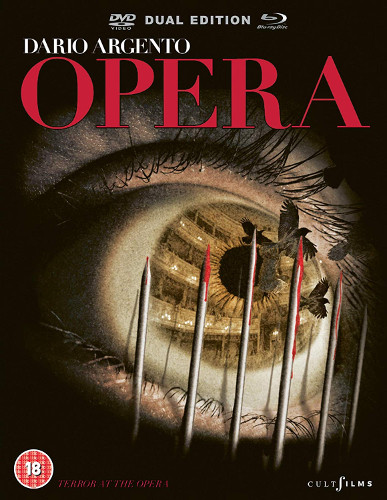
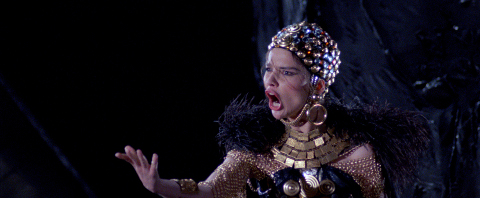
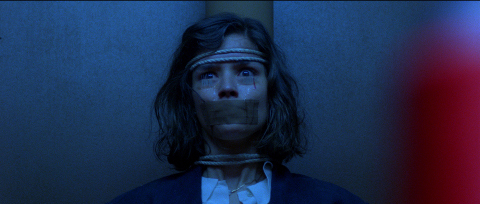



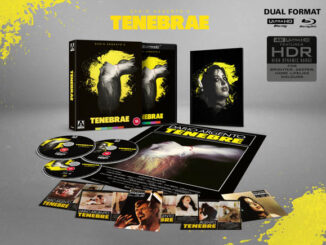
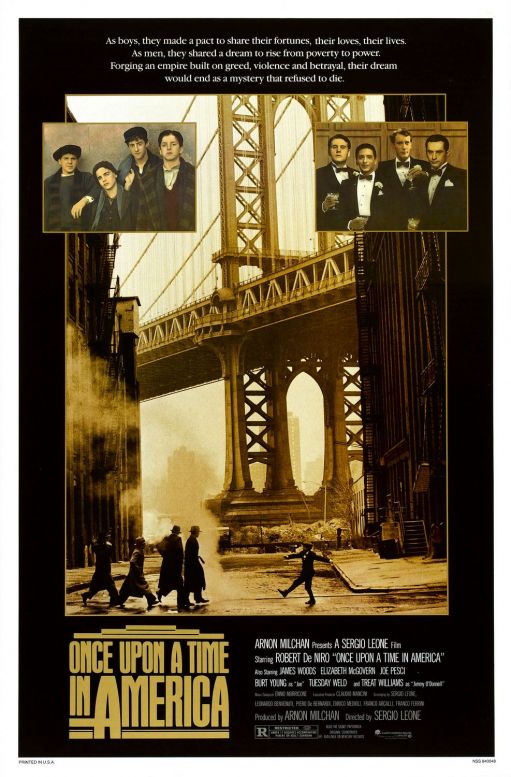
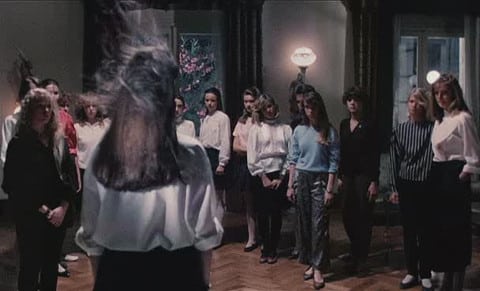
Be the first to comment